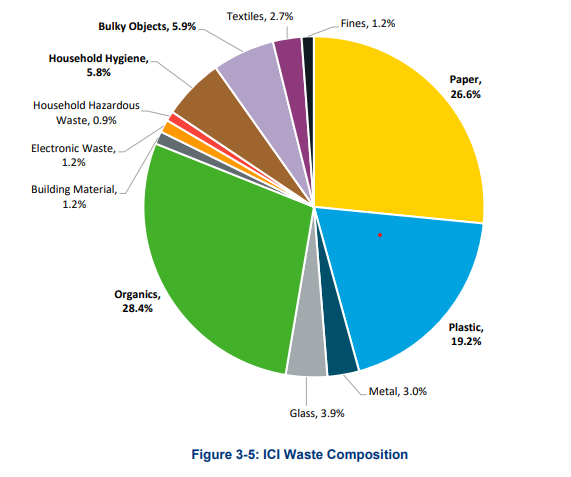Industrial, Commercial, Institutional
Under the solid waste bylaw, Industrial, Commercial, Institutional (ICI) properties are required to separate garbage, organics and recyclables into appropriate collection containers, without contamination, prior to disposal.
Four key changes:
- Waste must be separated into multiple streams: recyclable material, organic material and residual waste (garbage). View the Guide for Food Businesses and Organizations.
- Garbage must be placed in clear bags.
- Mixed waste must be limited to no more than 20% of total waste in the first year (2018), reducing 5% each year to a target of 5%.
- Building managers are required to provide educational material to residents, tenants, employees and contractors.
What is in ICI Waste?
In August 2020, the District of Squamish commissioned a waste composition report at the Squamish Landfill. By doing a waste composition study, we can determine what material is going into our landfill, a bit about where it is coming from, and make some assessments about where it should be going.
ICI Waste, or Industrial, Commercial, and Institutional, is all the waste that is generated at commercial properties, whether retail or industrial, or institutional properties such as the schools. The study found that approximately 47% of the waste that goes into the Squamish landfill is generated by the ICI sector. This is the largest segment, with residential waste representing 31% of the waste.
The graph below, from the 2024 waste composition study, shows that almost 75% of the garbage coming from ICI properties in Squamish is either organics, plastic or paper. Paper and Organics alone make up over 50% of the waste. These are materials that can and should be diverted from the waste stream to be either recycled or composted.

What are the first steps each business can take?
As with everything in your business, you can't improve what you don’t measure. Starting by tracking your current diversion, and doing your own waste composition audit or assessment is the best starting place. For the diversion, ask your service provider if they have information they can share with you. You can also estimate based on the volume collected each month. The Sustainability Coordinator can also provide a Diversion Calculator Template.
To determine your waste composition, there are some tools available in the Recycling Guides below, or in the resources section on how to do an audit for thorough data. However, you can start with a really simple assessment. Take a look in a couple of bags of garbage produced at different times of day in your business, and pull out the most common materials. Can they diverted? This is a starting point for making some recycling improvements.
For more recycling ideas, questions, signs or recycling training, please contact the Sustainability Coordinator.
Support and Resources
To support ICI properties with the changes, the District of Squamish is providing:
- Assistance with signage, informational materials, and implementation logistics.
- Guidance on waste room sizing, location and access.
- Free workshops about how the new bylaw will affect ICI properties
- A Waste Audit and Diversion Tool
Resources
- What can go in an organics bin
- How to reduce food waste
- What goes where
- How to plan your waste room/area
- Construction and Demolition Recycling Guide
- Restaurant and Food Vendor Recycling Guide
- Retail Recycling Guide
- Signage to download and print (Shared resources from Squamish-Lillooet Regional District website)
How to prevent odours to avoid attracting wildlife and rodents: To prevent odours to avoid attracting wildlife, keep the organic bin in a cool space, ask for more frequent collection and consider asking for bins to be washed or replaced. Make sure your garbage room is wildlife proof by keeping doors secured and bin lids down and locked at all times. Consider adding a seal to the bottom of your door.
How to reduce food waste:
Contact the Squamish Food Bank to learn how you can donated food before it goes to waste.
Solid Waste Changes for ICI FAQ
-
Why these changes?
Squamish sent an average of 676 kg of waste per person to the Squamish Landfill in 2016. A landfill audit in 2016 revealed that more than 65% of that waste going to the landfill could have been recycled or composted.
- The requirement for multi-stream separation at industrial, commercial, and institutional properties is expected to reduce this number.
- The requirement of clear plastic bags is intended to increase participation from those that do not presently divert recyclables or organic material from the waste stream.
- Diverting waste will maximize the remaining life of the landfill, delaying further costly solutions. Learn more about the landfill expansion project.
-
When do these changes come into effect?
The updated solid waste bylaw was adopted in September 5, 2017. A transition period provides time for necessary changes to infrastructure and systems to take place.
-
How impactful are these changes expected to be?
An audit conducted in May 2016 revealed that more than 65% of materials ending up in the landfill could have been recycled. Organics collection in ICI properties should help divert up to 30% of the volume of garbage generated. The audit also identified on-premise sorting options as a significant factor in waste diversion.
-
What is the goal of the Zero Waste Strategy
The goal of the Zero Waste Strategy is to achieve an average 350 kg per person per year disposal rate by 2020 with a corresponding diversion rate of 75%. The diversion rate is how much waste is diverted from the landfill, and is either recycled or composted instead. Click here to learn more about the Zero Waste Strategy.
